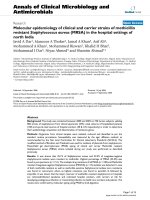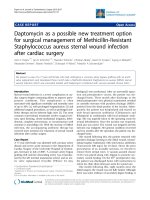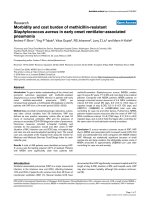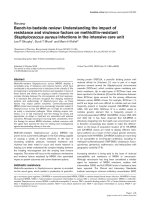Prevalence and antibiotic susceptibility pattern of methicillin resistant staphylococcus aureus (MRSA) at a Tertiary care hospital from northern India
Bạn đang xem bản rút gọn của tài liệu. Xem và tải ngay bản đầy đủ của tài liệu tại đây (180.15 KB, 7 trang )
Int.J.Curr.Microbiol.App.Sci (2019) 8(9): 2352-2358
International Journal of Current Microbiology and Applied Sciences
ISSN: 2319-7706 Volume 8 Number 09 (2019)
Journal homepage:
Original Research Article
/>
Prevalence and Antibiotic Susceptibility Pattern of
Methicillin Resistant Staphylococcus aureus (MRSA)
at a Tertiary Care Hospital from Northern India
Ayesha Nazar*, Yusuf Imran, Vichal Rastogi and Parul Singhal
Department of Microbiology, School of Medical Science and Research,
Sharda Hospital, Greater Noida, Uttar Pradesh, India
*Corresponding author
ABSTRACT
Keywords
World Health
Organization
(WHO), medicines,
MRSA infections
Article Info
Accepted:
22 August 2019
Available Online:
10 September 2019
MRSA is one of the major public health problems especially in developing
countries where irrational use of antibiotics has led to greater levels of
resistance. Increasing burden of MRSA infections in healthcare as well as
community setting warrants constant surveillance.
This study was
conducted from January 2018 to June 2019 at a tertiary care hospital to
know the prevalence and susceptibility pattern of MRSA. MRSA
identification was done with cefoxitin disc diffusion method. Out of the
total of 158 Staphylococcus aureus isolates, 59 (37.3%) were MRSA and
the remaining 99 (62.6%) isolates were MSSA. In our study 47.4% of the
MRSA isolates were hospital acquired MRSA while 52.5% were
community acquired MRSA. Majority of the isolates were obtained from
skin and soft tissue infections. This study showed a higher prevalence of
CA-MRSA. Consistent surveillance of strains circulating in particular
communities and hospitals along with formulation of rational antibiotic
policy would be helpful in reducing the incidence of MRSA infections.
Introduction
Antimicrobial resistance is an important
concern for the public health authorities at
global level. It is one of the major public
health problems especially in developing
countries where relatively easy availability
and higher consumption of medicines have led
to disproportionately higher incidence of
inappropriate use of antibiotics and greater
levels of resistance compared to developed
countries.
The CDC declared in 2013 that the human
race is now in the “post-antibiotic era,” and in
2014, the World Health Organization (WHO)
warned that the antibiotic resistance crisis is
becoming dire (WHO 2014). According to
2352
Int.J.Curr.Microbiol.App.Sci (2019) 8(9): 2352-2358
CDC estimates, 80461 invasive MRSA
infections and 11285 MRSA related deaths
occurred in 2011.
Methicillin resistant Staphylococcus aureus
(MRSA) was first detected in Britain in 1961
and is now quite common in hospitals around
the world. MRSA is now endemic in India.
The incidence of MRSA varies from 25 per
cent in western part of India to 50 per cent in
South India (Patel AK 2010, Gopalakrishnan
R 2010). A study conducted at 15 tertiary care
centers in India by Indian Network for
Surveillance of Antimicrobial Resistance
(INSAR) group reported MRSA rates among
outpatients, non-ICU inpatients and ICU
patients as 28%, 42% and 43% respectively in
2008 and 27%, 49% and 47% respectively in
2009 (Joshi S. et 2013). Since the beginning of
the MRSA expansion, infections due to this
organism were primarily limited to major
hospital centers and their healthcare systems.
Community-acquired MRSA was rarely
reported. However, during the 1990s, a new
epidemic of MRSA began where MRSA
strains were also isolated from apparently
healthy individuals in the communities with
no previous contact with healthcare
facilities.CA-MRSA strains often express
lower levels of resistance to oxacillin and
multiply faster than HA-MRSA strains with
significantly shorter doubling times which
may help CA-MRSA achieve successful
colonization by enabling it to out compete
commensal bacterial flora. CA-MRSA strains
are usually susceptible to multiple non–βlactam
antibiotics
like
trimethoprimsulfamethoxazole, clindamycin, tetracycline in
contrast to the multidrug resistance usually
seen in HA-MRSA strains (Robert C et al.,
2012).
The β-lactam resistance of MRSA is caused
by the acquisition of the exogenous mecA
gene. The mecA gene complex is comprised of
mecA together with its regulator genes, mecl
and mecR which reside within a mobile
genomic island known as the staphylococcal
cassette chromosome
mec (SCCmec).
SCCmec is composed of mec gene complex
which confers resistance to methicillin, and
the ccr gene complex which encodes
recombinases responsible for its mobility.
(Deresinski S. et al., 2005). To date 13
SCCmec types have been discovered.
(Lakhundi S.et al.,2018). The mecA gene
encodes for an alternative penicillin-binding
protein (PBP) designated PBP 2’ (or PBP 2a).
This altered PBP (i.e PBP2a) unlike the four
native PBPs (PBP1, PBP2, PBP3, PBP4) of S.
aureus, has remarkably reduced binding
affinities to β-lactam antibiotics.Hospital
acquired MRSA (HA-MRSA) are more likely
to have SCCmec subtype II & III (large
molecules, more likely to also contain multidrug resistance genes) while community
acquired MRSA (CA-MRSA) have subtype
IV & V (much smaller molecules, only carry
mecA gene). CA-MRSA often produces a
cytotoxin, Panton-Valentine leukocidin (PVL)
(Lakhundi S. et al., 2018).
This study was conducted to know the
prevalence and susceptibility pattern of
MRSA at a tertiary care hospital. The data
thus obtained would be helpful in surveillance,
control and formulation of rational antibiotic
policies for hospital and community acquired
MRSA.
Materials and Methods
The study was conducted at a tertiary care
hospital with 900 beds located in Northern
India, from January 2018 to June 2019.The
study population comprised of samples
obtained from patients of all age and sex who
were attending the hospital’s out-patient
department or were admitted in the hospital
and showed signs & symptoms of infection.
Relevant data about the patient’s illness was
obtained from hospital records.
2353
Int.J.Curr.Microbiol.App.Sci (2019) 8(9): 2352-2358
Sample collection and laboratory analysis
The isolates of the Staphylococcus aureus for
the study were obtained from clinical samples
comprising of blood, urine, pus, sputum,
pleural fluid, throat swab, high vaginal swab,
cerebrospinal fluid, endotracheal secretions,
catheter tip and other body fluids, that were
received in the bacteriology section of our
departmental
laboratory.
Preliminary
identification of bacterial isolate was done by
studying colony morphology, hemolysis on
blood agar plate, color changes on differential
media and enzymatic activity using catalase
and coagulase test. Following which, Gram
staining was performed for identifying Gram
Positive cocci. Also, isolated colonies were
sub-cultured onto
nutrient
agar for
biochemical testing and demonstration of any
pigment production (Mackie & McCartney
2006).
MRSA identification was done by cefoxitin
disk diffusion method. Inhibition zone size of
≥22mm using cefoxitin (30µg) disk was taken
as sensitive (MSSA) and zone size of ≤21mm
was taken to be Methicillin Resistant
Staphylococcus aureus (MRSA) as per
Clinical and Laboratory Standards Institute
(CLSI) recommendations (CLSI 2018).
Antibiotic susceptibility testing
Kirby Bauer Disc Diffusion method for
antibiotic susceptibility testing was performed
for all the bacterial isolates according to The
Clinical and Laboratory Standards Institute
(CLSI) guidelines using Mueller –Hinton's
Agar standard media. Commercially prepared
antimicrobial discs (Hi Media Laboratories,
Pvt. Limited, India) of 6mm diameter were
used for testing. All Staphylococcus aureus
isolates were subjected to antibiotic
susceptibility
testing
with
following
antibiotics- Penicillin (10 Unit), Cefoxitin (30
μg), Vancomycin (30 μg), Linezolid (30 μg),
Teicoplanin (30 μg), Amoxyclav (30 μg),
Clindamycin (2 μg), Erythromycin (15 μg),
Levofloxacin (5 μg), Ciprofloxacin (5 μg) and
Gentamicin (10 μg). The Antibiotic
susceptibility results were interpreted as either
Sensitive, Intermediate or Resistant to an
antimicrobial agent based on CLSI
interpretation guidelines 2018 (CLSI 2018).
Results and Discussion
Out of the total of 158 Staphylococcus aureus
isolates, 59 (37.34%) were Methicillin
resistant staphylococcus aureus (MRSA) and
the remaining 99 (62.66%) isolates were
Methicillin sensitive Staphylococcus aureus
(MSSA). Table 1
The MRSA isolates were further classified
into hospital acquired MRSA (HA-MRSA)
and community acquired MRSA (CA-MRSA).
Hospital acquired MRSA infection was
defined as occurring in a patient whose MRSA
isolate was cultured more than 48 hours after
admission to the hospital or who had a history
of hospitalization, surgery, dialysis or
residence in a long term health care facility
within 6 months prior to the culture date or
who had a indwelling intravenous line,
catheter or any other percutaneous medical
device present at the time the culture was
taken.
Patients with none of the above conditions
were classified as having community acquired
MRSA infection. In our study 28 (47.46%) of
the MRSA isolates were hospital acquired
MRSA while 31 (52.54%) were community
acquired MRSA. Table 2.
Sample wise distribution of the S.aureus
isolates showed that the highest number of
MRSA were isolated from pus (52.54%)
followed by blood (16.94%), sputum (8.47%)
and urine (8.47%). Table 3.
2354
Int.J.Curr.Microbiol.App.Sci (2019) 8(9): 2352-2358
All the isolates of Staphylococcus aureus were
tested for antibiotic susceptibility as described
under material and methods above. For urine
samples Nitrofurantoin and Norfloxacin were
also tested in addition to other antibiotics. The
resistance pattern of MSSA and MRSA
isolates against different antibiotics is depicted
in
table
4.
Methicillin
Sensitive
Staphylococcus aureus showed 100 %
sensitivity to Vancomycin, Teicoplanin,
Linezolid. Least sensitivity of MSSA was
noted for penicillin (42.4%) followed by
Ciprofloxacin (47.5%) and Erythromycin
(67.7%). All MSSA isolate from urine were
sensitive to Nitrofurantoin. Sensitivity to
Norfloxacin for urine samples was 70%. There
was no resistance of MSSA to Vancomycin,
Linezolid, Teicoplanin.
Erythromycin
(57.6%).
(71.2%)
and
Gentamicin
The severity of infections caused by MRSA is
thought to be higher than that caused by
methicillin-sensitive S. aureus (MSSA), not
because MRSA strains are in general more
virulent, but because they offer fewer
treatment options. Mounting evidence
suggests that MRSA infections lead to a
longer stay in hospitals, which in turn leads to
higher costs (Filice GA et al., 2010). The
present study included a total of 158 isolates
of Staphylococcus aureus. We identified 59
(37.34%) of these as MRSA and 99 (62.66%)
as MSSA. A study published in 2011 by
Indian Network for Surveillance of
Antimicrobial Resistance (INSAR) group, was
conducted in 15 Indian tertiary care centers
and reported a similar prevalence of MRSA at
40% (Joshi S. et al., 2013). Another study
from northern India conducted by Shetty J et
al., in 2017 also reported a MRSA
identification rate of 36.9% (Shetty S. et al.,
2017). Arora S et.al (Arora S et al., 2010), in
their study from Punjab reported a slightly
higher prevalence of 46% while the
prevalence was 38.4% in a study by Tiwari
HK from Uttar Pradesh (Tiwari et al., 2008).
Methicillin Resistant Staphylococcus aureus
(MRSA) showed 100% sensitivity to
Vancomycin and Teicoplanin, followed by
Linezolid (98.3%) and Amikacin (62.7%).
Isolates from urine samples showed 60%
sensitivity to Nitrofurantoin and 40%
sensitivity to Norfloxacin. The least sensitivity
was observed for Ciprofloxacin (16.9%)
followed by Levofloxacin (23.7%) and
Erythromycin (28.8%). There was 100%
resistance to penicillin, followed by
Ciprofloxacin (83.1%), Levofloxacin (76.3%),
Table.1 Distribution of MRSA and MSSA among Staphylococcus aureus isolates
Methicillin Susceptibility
MSSA
MRSA
Total
Number (n)
99
59
158
Percentage (%)
62.66
37.34
100
Table.2 Distribution of Hospital acquired and Community acquired MRSA
Community Acquired MRSA (CA-MRSA)
Hospital Acquired MRSA (HA-MRSA)
Total
2355
Number (n)
31
28
59
Percentage (%)
52.54
47.46
100
Int.J.Curr.Microbiol.App.Sci (2019) 8(9): 2352-2358
Table.3 Sample wise distribution of MRSA
Sample
Pus
Blood
Sputum
Urine
Throat/Nasal Swab
Drain tip
Vaginal Swab
Number (n=59)
31
10
5
5
3
3
2
Percentage (%)
52.54
16.94
8.47
8.47
5.08
5.08
3.38
Table.4 Antibiogram of Staphylococcus aureus (MSSA and MRSA)
Antibiotics
Penicillin G
Cefoxitin
Amikacin
Gentamicin
Erythromycin
Clindamycin
Ciprofloxacin
Levofloxacin
Vancomycin
Teicoplanin
Linezolid
Nitrofurantoin (15)
Norfloxacin (15)
Staphylococcus aureus
Resistance Pattern
(Total n= 158)
Number Percentage (%)
(n=158)
116
60
33
51
74
43
101
83
0
0
1
2
6
73.4
38
20.9
32.2
46.8
27.2
63.9
52.5
0
0
0.6
13.3
40
According to a recent study, the frequency of
45% of S. aureus clinical isolates being
methicillin-resistant in India is similar to what
has been reported in the rest of the Asian
countries (41.9% in Pakistan, 45.8% in China,
41% in Japan, 35.3% in Singapore and 55.9%
in Taiwan), except Hong Kong, Indonesia
(28% each) and South Korea (>70%) (Chen
CJ et al., 2014). The differences in prevalence
rates of MRSA reported from various centers
might be due to several factors like different
sample sizes and study population, difference
MSSA Resistance
Pattern
MRSA Resistance
Pattern
Number
(n=99)
Percentage
(%)
Number
(n=59)
Percentage
(%)
57
2
11
17
32
19
52
38
0
0
0
0 (n=10)
3 (n=10)
57.6
2.0
11.1
17.2
32.3
19.2
52.5
38.4
0
0
0
0
30
59
58
22
34
42
24
49
45
0
0
1
2 (n=5)
3 (n=5)
100
98.3
37.3
57.6
71.2
40.7
83.1
76.3
0
0
1.7
40
60
in healthcare facilities, pattern of antibiotic
usage and antibiotic policies and varying
infection control practices from hospital to
hospital. In our study 28 (47.46%) of the
MRSA isolates were hospital acquired while
31 (52.54%) were community acquired
MRSA. Many recent studies from Asia and
also from western countries have shown a
declining trend in the proportion of HAMRSA. The change in MRSA strains, owing
to the entry of CA-MRSA strains into
hospitals, has been proposed as a possible
2356
Int.J.Curr.Microbiol.App.Sci (2019) 8(9): 2352-2358
explanation. CA-MRSA isolates are now
being increasingly reported from India. D’
Souza et al., studied 412 confirmed cases of
MRSA and found that 4% were true CAMRSA which was similar to our study
(D’Souza N 2010).
Among all antibiotic classes, glycopeptides
emerged as the most effective class of
antibiotic against MRSA. All MRSA isolates
showed 100% sensitivity to Vancomycin and
Teicoplanin, followed by Linezolid (98.3%)
and Amikacin (62.7%). The epidemiology of
MRSA is constantly changing, with novel
MRSA clones appearing in different
geographical regions. Accurate and early
laboratory detection of MRSA is important for
institution of appropriate antibiotic treatment
and also for the prevention of the spread of
infection to other patients and health care
personnel. We hope that this study will serve
as a useful reference for clinical
microbiologists,
physicians
and
other
researchers interested in the study of
epidemiological characteristics and antibiotic
susceptibility pattern of MRSA.
References
Arora S, et al., Prevalence of Methicillinresistant
Staphylococcus
aureus
(MRSA) in a tertiary care hospital in
northern India. J Lab Physicians, 2010;
2:78–81.
Chen CJ et al., New epidemiology of
Staphylococcus aureus in Asia.
ClinMicrobiol Infect, 2014; 20:605–
23.
Clinical and Laboratory Standards Institute
(CLSI)2018. Performance standards
for antimicrobial susceptibility testing;
28th Edition. CLSI Supplement M200.
DeresinskiS.
Methicillin-resistant
Staphylococcus
aureus:
an
evolutionary,
epidemiologic,
and
therapeutic odyssey. Clin Infect Dis,
2005; 40(4): 562-73.
D’Souza N, et al., Molecular characterization
of Methicillin-resistant Staphylococcus
aureus with emergence of epidemic
clones of sequence type (ST)22 and ST
772 in Mumbai, India. J Clin
Microbiol., 2010;48:1806–11.
Filice GA,et al., Excess costs and utilization
associated with methicillin resistance
for patients with Staphylococcus
aureus infection. Infect Control Hosp
Epidemiol, 2010; 31:365–73.
Gopalakrishnan R, et al., Changing trends in
antimicrobial
susceptibility
and
hospital acquired infections over an
8year period in a tertiary care hospital
in relation to introduction of an
infection control programme. J Assoc
Physicians India, 2010; 58: 25-31.
Joshi S, et al., Methicillin resistant
Staphylococcus aureus (MRSA) in
India: Prevalence and susceptibility
pattern. Indian J Med Res., 2013;
137(2): 363-9.
Lakhundi
S.
Methicillin
resistant
Staphylococcus aureus: molecular
characterization,
evolution,
and
epidemiology. Clin Microbiol Rev,
2018;31(4):1-32.
Mackie & McCartney practical Medical
Microbiology 2006, Tests for the
identification of Bacteria, 14th edition,
Delhi: Elsevier publication, 131-150.
Patel AK, et al., Time trends in the
epidemiology of microbial infections
at a tertiary care centre in west India
over last 5 years. J Assoc Physicians
India 2010; 58: 37-40.
Robert C. Moellering. MRSA: the first half
century. Journal of Antimicrobial
Chemotherapy,2012; 67(1): 4–11.
Shetty J et al., Prevalence of constitutive and
inducible
clindamycin
resistance
among
clinical
isolates
of
Staphylococcus aureus in a tertiary
2357
Int.J.Curr.Microbiol.App.Sci (2019) 8(9): 2352-2358
care institute in North India. Int J Res
Med Sci., 2017; 5(7):3120-25.
Tiwari HK, et al., 2008. High prevalence of
multidrug-resistant MRSA in a tertiary
care hospital of northern India.
Infection and Drug Resistance,2008;
1:57–61.
WHO 2014. Antimicrobial Resistance: Global
Report on Surveillance.
How to cite this article:
Ayesha Nazar, Yusuf Imran, Vichal Rastogi and Parul Singhal 2019. Prevalence and Antibiotic
Susceptibility Pattern of Methicillin Resistant Staphylococcus aureus (MRSA) at a Tertiary
Care Hospital from Northern India. Int.J.Curr.Microbiol.App.Sci. 8(09): 2352-2358.
doi: />
2358









